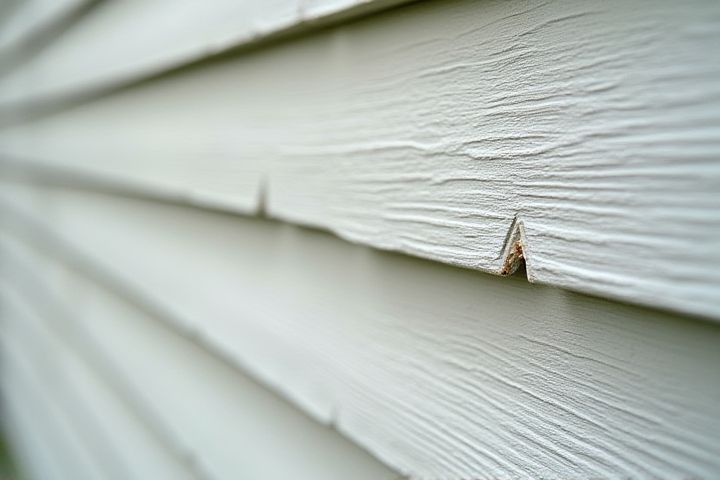
House siding may require replacement due to various factors, including weather damage, rot, and pest infestations. Exposure to harsh elements such as heavy rain, snow, or intense sunlight can lead to faded, cracked, or warped siding materials, compromising your home's insulation and aesthetic appeal. Wood siding is particularly susceptible to moisture, causing mold growth and structural deterioration over time. Vinyl or aluminum siding can also become brittle and lose their color due to prolonged UV exposure. Regular inspections and maintenance are essential to identify early signs of damage, ensuring the longevity and protection of your home's exterior.
Why House Siding Needs Replacement
Weather damage
Weather damage significantly impacts house siding, leading to deterioration and reduced insulation efficiency. Constant exposure to harsh elements such as rain, snow, and UV rays can result in fading, cracking, or warping, often requiring replacement every 10 to 20 years. Moisture intrusion due to compromised siding can lead to rot and mold, posing health risks and structural issues. By addressing weather damage promptly, you can maintain your home's curb appeal and protect its value effectively.
Fading and discoloration
Fading and discoloration are common signs that your house siding requires replacement, marking deterioration caused by prolonged exposure to sunlight and severe weather conditions. Over time, UV rays break down the pigments in siding materials, leading to a dull appearance that can detract from your home's curb appeal. This discoloration also indicates potential underlying damage, such as wood rot or mold growth, that could compromise your home's structural integrity if left unaddressed. To maintain a vibrant and protective exterior, consider timely replacement of faded siding materials with high-quality, UV-resistant options that enhance both aesthetics and durability.
Warping and cracking
Warping and cracking in house siding are signs of material deterioration, often due to moisture exposure or temperature fluctuations. These issues compromise the structural integrity of your home, allowing water infiltration that can lead to mold growth and wood rot. As siding materials expand and contract, they can become misaligned, resulting in gaps that affect insulation and energy efficiency. Addressing these problems promptly not only enhances curb appeal but also safeguards your home's overall health and value.
Mold and mildew growth
House siding is susceptible to mold and mildew growth due to prolonged exposure to moisture and humidity, which can lead to structural damage if left untreated. Signs of mold include black or green spots on the surface, while mildew typically appears as a white powdery substance. Statistics indicate that 40% of households have mold growth, which can negatively impact indoor air quality and your health, particularly for those with allergies or respiratory issues. Ignoring these signs not only compromises your home's aesthetics but may also decrease its value, making timely replacement essential for both appearance and safety.
Increased energy costs
Old or damaged house siding can significantly contribute to increased energy costs due to poor insulation and air leakage. When siding becomes worn, it allows drafts to enter and conditioned air to escape, forcing your heating and cooling systems to work harder. This inefficiency not only raises your monthly energy bills but can also strain HVAC equipment, leading to costly repairs or replacements over time. Investing in new, energy-efficient siding can enhance your home's thermal performance, ultimately saving you money on energy expenses.
Pest infestation
House siding is crucial for protecting your home's structure from various elements, including pests. When siding deteriorates, it can develop cracks and gaps, creating an easy entry point for rodents, termites, and other pests. A pest infestation can lead to severe damage, including weakened walls and mold growth, which compromises your home's integrity. Replacing worn-out siding not only enhances your home's appearance but also fortifies it against pest invasions, ensuring a safer living environment.
Rotting materials
Rotting materials in house siding can lead to significant structural issues, compromising your home's integrity and leading to costly repairs. Over time, exposure to moisture and pests causes wood siding to decay, resulting in mold growth and attracting insects like termites. If you notice soft spots, discoloration, or peeling paint on your siding, these are clear indicators of rot that necessitate immediate attention. Replacing rotting siding not only enhances your home's curb appeal but also protects against further damage and improves energy efficiency.
Loss of structural integrity
House siding plays a crucial role in maintaining the structural integrity of your home. Over time, weather conditions, moisture exposure, and pest infestations can lead to significant deterioration of siding materials, such as wood, vinyl, or fiber cement. When siding loses its protective function, it can allow water infiltration, which may cause mold growth, wood rot, and damage to underlying structures like studs or insulation. As these issues escalate, you may face costly repairs, making timely siding replacement essential to safeguard your home's stability and value.
Curb appeal impact
Worn or damaged house siding significantly diminishes curb appeal, adversely affecting the overall look of your home. Faded colors, peeling paint, or warped panels create an unkempt appearance that can deter potential buyers or even passersby. Upgrading to fresh, attractive siding materials not only revitalizes your home's exterior but also enhances its value in the real estate market. Maintaining appealing siding is essential for creating a welcoming atmosphere that reflects your personal style and care for your property.
Property value maintenance
Replacing your house siding is essential for maintaining property value, as it directly affects curb appeal and overall aesthetic. Deteriorating siding can lead to issues such as moisture damage, pest infestation, and increased energy costs, which in turn diminish your home's marketability. High-quality, well-maintained siding enhances insulation, thus improving energy efficiency, which buyers often prioritize. Investing in new siding not only protects your home but also assures prospective buyers that they are making a wise investment.
